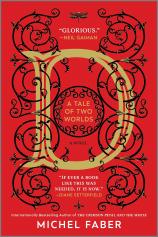D (A Tale of Two Worlds)
Review
D (A Tale of Two Worlds)
Michel Faber’s D (A TALE OF TWO WORLDS) is a fascinating, fantastic fever-dream of a novel. References and homages to other literary pieces, films, political figures and events, as well as philosophical observations, abound. But every element of this marvelous work merges into an imaginatively constructed plot that clearly demonstrates the classical “Hero and the Quest” genre but morphs into an ingenious and unique twist on that literary form.
The hero who embarks on the quest in this case is a youngster who is just beginning her secondary school career with all the inherent difficulties therein. Her name is Dhikilo, and she was born in a place called Somaliland --- which, as far as anybody knows, doesn’t really exist. It’s supposed to be in Africa, somewhere near Somalia, and its inhabitants are people of color, as is Dhikilo. So World Number One in this Tale of Two Worlds is very much like our own. Dhikilo is an “other” in Cawber, England, where she lives with her adoptive parents, having lost both her birth parents before she ever knew them, and she suffers all the indignities, slights and overt and covert humiliations that “others” face all over this world.
In Book and World Number One, everything seems rather normal in a Dickensian sort of way --- at first. But soon, two strange events and two strange characters emerge, and the semi-realistic nature of the world becomes blurry and opaque. The first strange event occurs when Dhikilo awakens one morning and discovers, while conversing with her English parents, that in all the words that include the letter D, that letter is now missing. To make matters even worse, all street signs and street names have no Ds, and everyone to whom she speaks does not use or even recognize the letter or its sound. It has simply vanished. So Dhikilo’s few friends, who used to call her Dicky, now call her Icky. Dhikilo, as we might imagine, is annoyed and mystified in equal measure. And from here to the end, the novel’s magic and mysteries magnify and multiply. But we are still residing in World Number One.
The second significant event is the appearance of Mr. Charles Dodderfield. The doddering 90-plus-year-old gentleman is a retired teacher --- Dhikilo’s favorite --- who is now blind and is most often seen wandering aimlessly around the neighborhood with his big brown dog, whose name is either Nelly or Mrs. Robinson, depending on who is addressing her. Dhikilo is informed that Dodderfield has died, and she attends his funeral. She then visits his home because she is concerned about the welfare of Mrs. Robinson. There, she discovers that Dodderfield is very much alive and that Mrs. Robinson is actually a magical creature called a sphinx, who is capable at any time of turning herself from a Labrador retriever into an absurdly large cat-like being with a lovely human face, curly blond hair, sharp teeth and a tail that turns into a snake on command. Together, Dodderfield and Mrs. Robinson persuade Dhikilo that she must visit another world, a much more dangerous one, in order to find and return the letter D to its rightful place in the language and their world. Mrs. Robinson will be her partner and her guide. And so ends Book One.
"[E]very element of this marvelous work merges into an imaginatively constructed plot that clearly demonstrates the classical “Hero and the Quest” genre but morphs into an ingenious and unique twist on that literary form."
Book Two takes us along with Dhikilo and Mrs. Robinson as they journey in and through the dark, cold, snowy, stormy Land of Liminus. Its population includes a variety of partly human beings --- some evil, some disgusting, some kind and generous, some laughably stupid and awkward, and one murderous, greedy, immoral, lying, puffed-up dictator who is 100% responsible for the disappearance of the Ds. We experience the characters, phenomena, events and situations encountered by the two travelers.
First --- actually as a Book One transition to Book Two --- they see hordes of dragonflies soaring overhead, all grouped in a perfectly straight line, each one carrying a shiny object in its feet as they make their way to a mysterious destination. These objects turn out to be the missing Ds, so the intrepid duo decide to follow the insects’ trail. From this point, now well on their way, they experience seven separate adventures. They soon meet the Magwitches, four mean old ugly hags who warn the travelers about the murderous Gamp, the ruler, while themselves making threatening gestures toward the dog and the child. They’re chased away by Mrs. Robinson in sphinx form. The two then become very tired, so they’re relieved to see Bleak House, a very fancy-looking hotel. But there are signs all over the place from “The Management” demanding obedience to strict, strange, increasingly threatening rules, until finally the duo recognizes that the hotel is, in fact, a prison, designed so that its guests can never leave. It’s the Liminusian version of the Hotel California. But Dhikilo figures out the means of escape, and she and Mrs. Robinson finally free themselves from the hotel’s clutches.
After that terrifying experience with an apparently inorganic magical entity, the next threat is their encounter with the Quilps, dwarf-like creatures who resemble greasy pigs. They’re warlike and stupid, and they are determined to kill both visitors and have them for dinner. But once again, Dhikilo’s wit and Mrs. Robinson’s strength save the pair, and they’re off to another adventure. Their next hosts are the Droods, large catlike beings who possess some indefinable human-like qualities, this time positive ones. They are kind, generous and warm. Dhikilo accompanies them to their chapel and teaches them a song that they adapt to their own language and musical style and use as a prayer to wish for relief from the cold and storms that have plagued all of Liminus for many years. Miraculously, the prayer works. The sun appears, the snow disappears, and Dhikilo becomes a virtual goddess to these admirable beings.
As they finally approach the Gamp’s home city, Gampalonia, the pair must get past the well-meaning but quite ignorant gatekeeper, Inspector Pumblechook, the bumbler who is as silly as his name. After they convince him that they are trustworthy, they arrive at the border of Gampalonia, where they find a hilarious Gampalonian souvenir shop, which, of course, sells all kinds of ridiculous Gampalonian memorabilia, one piece of which is significant. It’s a model of the shining tower that is the Gamp’s pride and joy. They don’t buy it --- they have no money --- but certainly do remember it.
Almost immediately upon entering Gampalonia proper, where they see the real tower, they are warned that “ogs” have been outlawed by their ruler, and ignoring the law will result in the death penalty. Mrs. Robinson cannot make herself into the sphinx because her appearance and strength would surely result in their immediate execution. Dhikilo is thrown into jail and will be sentenced to death and executed via guillotine the next morning after the pseudo-trial hosted by the Gamp himself. A huge crowd will gather in the town square, all very excited to witness the beheading of this strange girl who has broken laws and brought her alien ways --- and her “og” --- to Gampalonia.
Faber’s concoction of magical beings and events is brilliant on several levels. It’s a morality tale that examines the dangers of authoritarian figures and their societies, the often-ugly foibles of human nature, the horrors of the hatred and violence we inflict on each other, the utter failures of political entities ruled by stupid people, the all-too-human tendency to fear and loathe those who are “different,” and even the rewards of positive human qualities --- kindness, generosity, intelligence, empathy, determination.
In an Author’s Note, Faber recognizes the authors whose works inspired his story, among them Charles Dickens and A TALE OF TWO CITIES, and C. S. Lewis and the Narnia stories. However, he does not cite L. Frank Baum, whose THE WONDERFUL WIZARD OF OZ seems to act almost as a guiding light for his work here.
Also not directly addressed are the stunning similarities of the primary villain to a certain American political figure: a man who says, “Only I can fix it”; a coward who puffs himself up while masquerading as an icon of power; advisers who fawn on him; a glitzy tower and even a hotel as symbols of that fragile pseudo-power; beings who are not just witches but magwitches; and a one-syllable name ending in “mp.”
I enthusiastically recommend this most unusual piece of literature, which amazingly manages to be both brilliantly derivative and absolutely unique.
And best of all, it efinitely boasts a happy ening. On't miss it!
Reviewed by Jack Kramer on January 8, 2021
D (A Tale of Two Worlds)
- Publication Date: October 26, 2021
- Genres: Adventure, Fantasy, Fiction, Magical Realism
- Paperback: 304 pages
- Publisher: Hanover Square Press
- ISBN-10: 133547479X
- ISBN-13: 9781335474797




